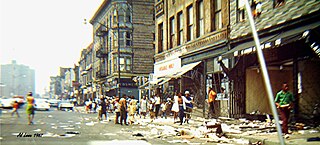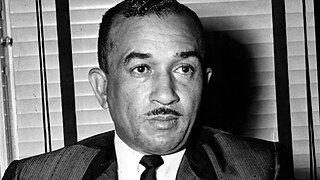Related Research Articles
In the broader context of racism in the United States, mass racial violence in the United States consists of ethnic conflicts and race riots, along with such events as:

The 1967 Detroit riot, also known as the 12th Street Riot and the Detroit Uprising, was the bloodiest of the urban riots in the United States during the "long, hot summer of 1967". Composed mainly of confrontations between African American residents and the Detroit Police Department, it began in the early morning hours of Sunday July 23, 1967, in Detroit, Michigan.

The 1967 Newark riots were an episode of violent, armed conflict in the streets of Newark, New Jersey. Taking place over a four-day period, the Newark riots resulted in at least 26 deaths and hundreds more serious injuries. Serious property damage, including shattered storefronts and fires caused by arson, left many of the city's buildings damaged or destroyed. At the height of the conflict, the National Guard was called upon to occupy the city with tanks and other military equipment, leading to iconic media depictions that were considered particularly shocking when shared in the national press. In the aftermath of the riots, Newark was quite rapidly abandoned by many of its remaining middle-class and affluent residents, as well as much of its white working-class population. This accelerated flight led to a decades-long period of disinvestment and urban blight, including soaring crime rates and gang activity.

Cecil Bassett Moore was an American lawyer, politician and civil rights activist who served as president of the Philadelphia NAACP chapter and as a member of Philadelphia's city council. He led protests to desegregate Girard College.
The 1991 Washington, D.C., riot, sometimes referred to as the Mount Pleasant riot or Mount Pleasant Disturbance, occurred in May 1991, when rioting broke out in the Mount Pleasant neighborhood of Washington, D.C., in response to an African-American female police officer having shot a Salvadoran man in the chest following a Cinco de Mayo celebration.

North Philadelphia, nicknamed North Philly, is a section of Philadelphia, Pennsylvania. It is immediately north of Center City. Though the full extent of the region is somewhat vague, "North Philadelphia" is regarded as everything north of either Vine Street or Spring Garden Street, between Northwest Philadelphia and Northeast Philadelphia. It is bordered to the north by Olney Ave along Broad Street, Spring Garden Street to the south, 35th Street to the west and Adams Avenue to the east. The Philadelphia Police Department patrols five districts located within North Philadelphia: the 22nd, 25th, 26th, 35th and 39th districts. There are thirteen ZIP codes for North Philadelphia: 19120, 19121, 19122, 19123, 19125, 19126, 19130, 19132, 19133, 19134, 19137, 19140 and 19141.
The 1964 Rochester race riot was a riot that occurred in 1964 in Rochester, New York, United States. The riot occurred in the context of a rapidly-growing African American population in Rochester which had experienced discrimination in employment, housing, and policing in the preceding years. Violence began when the Rochester Police Department attempted to make an arrest at a block party on July 24, 1964. The riot lasted until July 26 and resulted in five deaths, four of which occurred in a helicopter crash in the city, as well as over 300 injuries and 900 arrests. In the aftermath of the riot, downtown Rochester received the attention of several new urban renewal and public housing projects, and local activists organized campaigns to change hiring practices in the city.

The 1943Detroit race riot took place in Detroit, Michigan, from the evening of June 20 through to the early morning of June 22. It occurred in a period of dramatic population increase and social tensions associated with the military buildup of U.S. participation in World War II, as Detroit's automotive industry was converted to the war effort. Existing social tensions and housing shortages were exacerbated by racist feelings about the arrival of nearly 400,000 migrants, both African-American and White Southerners, from the Southeastern United States between 1941 and 1943. The migrants competed for space and jobs against the city's residents as well as against European immigrants and their descendants. The riot escalated after a false rumor spread that a mob of whites had thrown a black mother and her baby into the Detroit River. Blacks looted and destroyed white property as retaliation. Whites overran Woodward to Veron where they proceeded to violently attack black community members and tip over 20 cars that belonged to black families.
Riots often occur in reaction to a perceived grievance or out of dissent. Riots may be the outcome of a sporting event, although many riots have occurred due to poor working or living conditions, government oppression, conflicts between races or religions.

Avondale is one of the 52 neighborhoods of Cincinnati, Ohio. It is home to the Cincinnati Zoo and Botanical Garden. The population was 11,345 at the 2020 census.

The Harlem riot of 1964 was a race riot that occurred between July 16 and 22, 1964 in the New York City neighborhoods of Harlem and Bedford-Stuyvesant, United States. It began after James Powell, a 15-year-old African American, was shot and killed by police Lieutenant Thomas Gilligan in front of Powell's friends and about a dozen other witnesses. Hundreds of students from Powell's school protested the killing. The shooting set off six consecutive nights of rioting. By some accounts, 4,000 people participated in the riots. People attacked the New York City Police Department (NYPD), destroyed property, and looted stores. Several rioters were severely beaten by NYPD officers. The riots and unrest left one dead, 118 injured, and 465 arrested.
The 1969 York race riot refers to a period of racial unrest in York, Pennsylvania in July 1969. This period of increased racial unrest followed a period of significant racial tension, rioting and racial justice protests that were taking place in multiple cities across Pennsylvania and the nation, during and after the Civil rights movement — actions that had endeavored to abolish multiple forms of legalized institutional racism in the United States through primarily nonviolent methods between 1954 and 1968.

The King assassination riots, also known as the Holy Week Uprising, were a wave of civil disturbance which swept across the United States following the assassination of Martin Luther King Jr. on April 4, 1968. Some of the biggest riots took place in Washington, D.C., Baltimore, Chicago, and Kansas City.
The Cambridge riot of 1967 was one of 159 race riots that swept cities in the United States during the "Long Hot Summer of 1967". This riot occurred on July 24, 1967 in Cambridge, Maryland, a county seat on the Eastern Shore. For years racial tension had been high in Cambridge, where black people had been limited to second-class status. Activists had conducted protests since 1961, and there was a riot in June 1963 after the governor imposed martial law. "The Treaty of Cambridge" was negotiated among federal, state, and local leaders in July 1963, initiating integration in the city prior to passage of federal civil rights laws.
The 1967 Milwaukee riot was one of 159 race riots that swept cities in the United States during the "Long Hot Summer of 1967". In Milwaukee, Wisconsin, African American residents, outraged by the slow pace in ending housing discrimination and police brutality, began to riot on the evening of July 30, 1967. The inciting incident was a fight between teenagers, which escalated into full-fledged rioting with the arrival of police. Within minutes, arson, looting, and sniping were occurring in the north side of the city, primarily the 3rd Street Corridor.
The 1967 Minneapolis disturbance was one of the 159 disturbances that swept across cities in the United States during the "long, hot summer of 1967".
The 1967 Riviera Beach riot was one of 159 riots during the Long, hot summer of 1967. It originated at the Blue Heron Bar in Riviera Beach, Florida and involved 400 rioters swarming the establishment. Forty-five people were arrested over the four hours it took to disperse the riot, including 14 teenagers in nearby West Palm Beach who were in possession of bomb-making materials.
Howard R. Leary was an American law enforcement officer who served as Commissioner of the Philadelphia Police Department from 1963 to 1966 and New York City Police Commissioner from 1966 to 1970.
References
- ↑ Nicole Maurantonio, “Standing By: Police Paralysis, Race, and the 1964 Philadelphia Riot,” Journalism History, 38 (Summer 2012), 110–21.
- 1 2 3 Doing No Good Time Magazine
- 1 2 No Other Life
- ↑ Courtney Ann Lyons, "Burning Columbia Avenue: Black Christianity, Black Nationalism, and 'Riot Liturgy' in the 1964 Philadelphia Race Riot," Pennsylvania History (2010) 77#3 pp 324-348.
- ↑ Clark, Joe (August 31, 1964). "Riot Caught City with Procedures Down". Philadelphia Daily News. Retrieved June 5, 2020.
- ↑ "The Philadelphia race riot of August 1964". Philly.com. Philadelphia Media Network (Digital), LLC. Retrieved 5 February 2017.
- ↑ "Ruminating On Lost Columbia Avenue". Hidden City Philadelphia. Hidden City Philadelphia. Retrieved 5 February 2017.